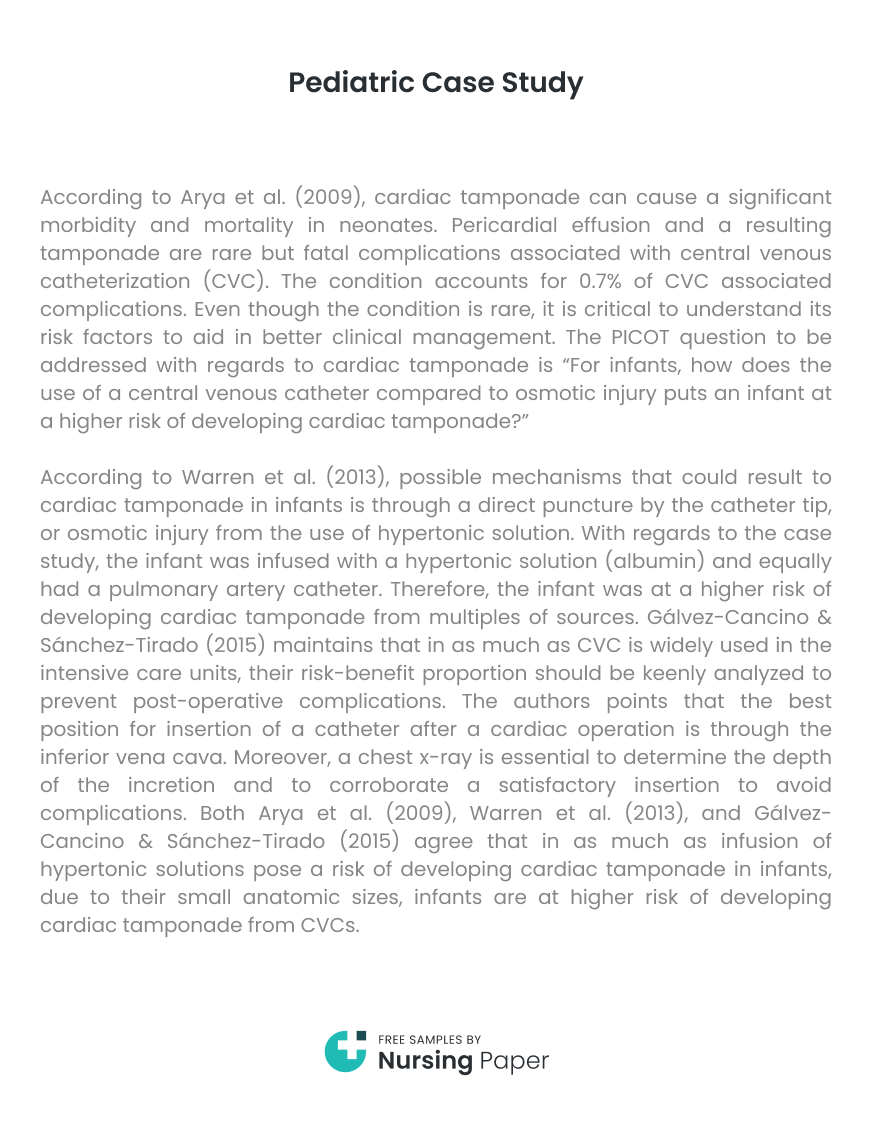
Introduction
According to Arya et al. (2009), cardiac tamponade can cause a significant morbidity and mortality in neonates. Pericardial effusion and a resulting tamponade are rare but fatal complications associated with central venous catheterization (CVC). The condition accounts for 0.7% of CVC associated complications. Even though the condition is rare, it is critical to understand its risk factors to aid in better clinical management. The PICOT question to be addressed with regards to cardiac tamponade is “For infants, how does the use of a central venous catheter compared to osmotic injury puts an infant at a higher risk of developing cardiac tamponade?”
According to Warren et al. (2013), possible mechanisms that could result to cardiac tamponade in infants is through a direct puncture by the catheter tip, or osmotic injury from the use of hypertonic solution. With regards to the case study, the infant was infused with a hypertonic solution (albumin) and equally had a pulmonary artery catheter. Therefore, the infant was at a higher risk of developing cardiac tamponade from multiples of sources. Gálvez-Cancino & Sánchez-Tirado (2015) maintains that in as much as CVC is widely used in the intensive care units, their risk-benefit proportion should be keenly analyzed to prevent post-operative complications. The authors points that the best position for insertion of a catheter after a cardiac operation is through the inferior vena cava. Moreover, a chest x-ray is essential to determine the depth of the incretion and to corroborate a satisfactory insertion to avoid complications. Both Arya et al. (2009), Warren et al. (2013), and Gálvez-Cancino & Sánchez-Tirado (2015) agree that in as much as infusion of hypertonic solutions pose a risk of developing cardiac tamponade in infants, due to their small anatomic sizes, infants are at higher risk of developing cardiac tamponade from CVCs.


1. Franco Gálvez-Cancino & María de la Luz Sánchez-Tirado. (2015). Cardiac tamponade associated with umbilical venous catheter (UVC) placed in inappropriate position.
2. Mikako Warren, Karen S. Thompson, Edwina J. Popek, Hannes Vogel & John Hicks. (2013). Pericardial Effusion and Cardiac Tamponade in Neonates: Sudden Unexpected Death Associated with Total Parenteral Nutrition via Central Venous Catheterization.
3. Swati O. Arya, Gurumurthy M. Hiremath, Kingsley C. Okonkwo, and Michael D. Pettersen. (2009). Central Venous Catheter-Associated Pericardial Tamponade in a 6-Day Old: A Case Report.



The download will start shortly.

The download will start shortly.
 Subject:
Medicine
Subject:
Medicine  Number of pages: 2
Number of pages: 2  Subject:
Medicine
Subject:
Medicine  Number of pages: 9
Number of pages: 9  Subject:
Health and Social Care
Subject:
Health and Social Care  Number of pages: 2
Number of pages: 2  Subject:
Medicine
Subject:
Medicine  Number of pages: 6
Number of pages: 6  Subject:
Medicine
Subject:
Medicine  Number of pages: 3
Number of pages: 3  Subject:
Medicine
Subject:
Medicine  Number of pages: 2
Number of pages: 2  Subject:
Medicine
Subject:
Medicine  Number of pages: 8
Number of pages: 8  Subject:
Medicine
Subject:
Medicine  Number of pages: 6
Number of pages: 6  Subject:
Medicine
Subject:
Medicine  Number of pages: 5
Number of pages: 5  Subject:
Medicine
Subject:
Medicine  Number of pages: 5
Number of pages: 5  Subject:
Nursing
Subject:
Nursing  Number of pages: 3
Number of pages: 3  Subject:
Nursing
Subject:
Nursing  Number of pages: 8
Number of pages: 8  Subject:
Medicine
Subject:
Medicine  Number of pages: 2
Number of pages: 2  Subject:
Medicine
Subject:
Medicine  Number of pages: 7
Number of pages: 7  Subject:
Health and Social Care
Subject:
Health and Social Care  Number of pages: 2
Number of pages: 2 
